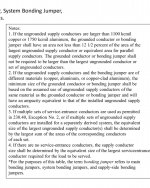hhsting
Senior Member
- Location
- Glen bunie, md, us
- Occupation
- Junior plan reviewer
I have quick question on sizing system bonding jumper.
I have 3 sets of 600kcmil AL transformer secondary conductor
By calculation I would get 3x600 = 1800 kcmil. 1800x0.125 = 225 kcmil AL.
Their is no 225 kcmil AL shown on NEC 2017 Table 310.16. Next standard size is 250kcmil AL.
Changing to copper I would get equivalent ampacity for 250kcmil AL to be 4/0 copper.
However engineer has provided 3/0 copper. I can see from where since NEC 2017 Table 250.102(C)(1) goes up to 1750 kcmil AL which is 20/ awg. Assuming the table where to continue it would be over 1750 kcmil Al to over xxx kcmil Al would equal 3/0 awg copper.
I am not sure would 3/0 awg copper be ok or 4/0 awg copper? There is no ampacity table for NEC 2017 Table 310.16
I have 3 sets of 600kcmil AL transformer secondary conductor
By calculation I would get 3x600 = 1800 kcmil. 1800x0.125 = 225 kcmil AL.
Their is no 225 kcmil AL shown on NEC 2017 Table 310.16. Next standard size is 250kcmil AL.
Changing to copper I would get equivalent ampacity for 250kcmil AL to be 4/0 copper.
However engineer has provided 3/0 copper. I can see from where since NEC 2017 Table 250.102(C)(1) goes up to 1750 kcmil AL which is 20/ awg. Assuming the table where to continue it would be over 1750 kcmil Al to over xxx kcmil Al would equal 3/0 awg copper.
I am not sure would 3/0 awg copper be ok or 4/0 awg copper? There is no ampacity table for NEC 2017 Table 310.16

